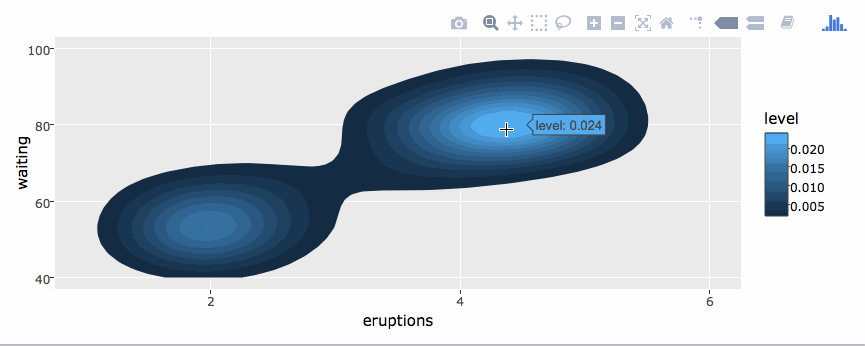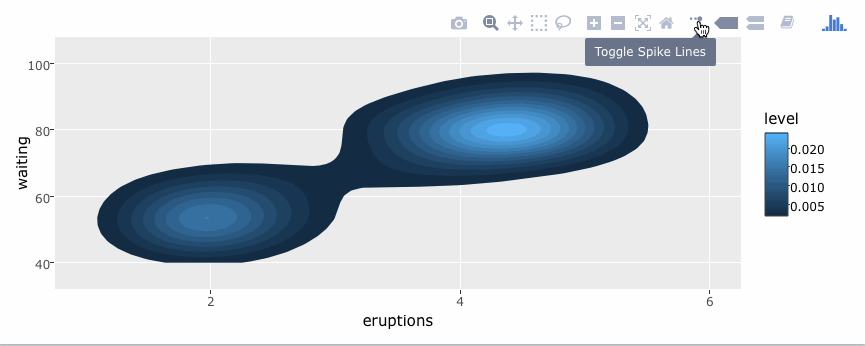Ecosyste.ms: Awesome
An open API service indexing awesome lists of open source software.
https://github.com/plotly/plotly.R
An interactive graphing library for R
https://github.com/plotly/plotly.R
d3js data-visualization ggplot2 javascript plotly r r-package rstats shiny webgl
Last synced: 3 months ago
JSON representation
An interactive graphing library for R
- Host: GitHub
- URL: https://github.com/plotly/plotly.R
- Owner: plotly
- License: other
- Created: 2013-11-21T05:56:51.000Z (about 11 years ago)
- Default Branch: master
- Last Pushed: 2024-09-20T13:59:57.000Z (5 months ago)
- Last Synced: 2024-10-29T15:10:54.368Z (4 months ago)
- Topics: d3js, data-visualization, ggplot2, javascript, plotly, r, r-package, rstats, shiny, webgl
- Language: R
- Homepage: https://plotly-r.com
- Size: 108 MB
- Stars: 2,555
- Watchers: 115
- Forks: 625
- Open Issues: 709
-
Metadata Files:
- Readme: README.md
- Contributing: CONTRIBUTING.md
- License: LICENSE
Awesome Lists containing this project
- awesome-starred - plotly - An interactive graphing library for R (R)
- awesome-shiny-extensions - plotly - Interactive web graphics via plotly.js. Has special support for linking/highlighting/filtering views. (Visualization / General-Purpose)
- jimsghstars - plotly/plotly.R - An interactive graphing library for R (R)
README

[](https://github.com/plotly/plotly.R/actions)
[](https://cran.r-project.org/package=plotly)
[](https://cranlogs.r-pkg.org/badges/grand-total/plotly)
[](https://cranlogs.r-pkg.org/badges/plotly)
An R package for creating interactive web graphics via the open source
JavaScript graphing library
[plotly.js](https://github.com/plotly/plotly.js).
## Installation
Install from CRAN:
``` r
install.packages("plotly")
```
Or install the latest development version (on GitHub) via `{remotes}`:
``` r
remotes::install_github("plotly/plotly")
```
## Getting started
### Web-based ggplot2 graphics
If you use [ggplot2](https://github.com/tidyverse/ggplot2), `ggplotly()`
converts your static plots to an interactive web-based version\!
``` r
library(plotly)
g <- ggplot(faithful, aes(x = eruptions, y = waiting)) +
stat_density_2d(aes(fill = ..level..), geom = "polygon") +
xlim(1, 6) + ylim(40, 100)
ggplotly(g)
```

By default, `ggplotly()` tries to replicate the static ggplot2 version
exactly (before any interaction occurs), but sometimes you need greater
control over the interactive behavior. The `ggplotly()` function itself
has some convenient “high-level” arguments, such as `dynamicTicks`,
which tells plotly.js to dynamically recompute axes, when appropriate.
The `style()` function also comes in handy for *modifying* the
underlying trace
attributes (e.g. [hoveron](https://plotly.com/r/reference/#scatter-hoveron)) used to generate the plot:
``` r
gg <- ggplotly(g, dynamicTicks = "y")
style(gg, hoveron = "points", hoverinfo = "x+y+text", hoverlabel = list(bgcolor = "white"))
```

Moreover, since `ggplotly()` returns a plotly object, you can apply
essentially any function from the R package on that object. Some useful
ones include `layout()` (for [customizing the
layout](https://plotly-r.com/improving-ggplotly.html#modifying-layout)),
`add_traces()` (and its higher-level `add_*()` siblings, for example
`add_polygons()`, for [adding new
traces/data](https://plotly-r.com/improving-ggplotly.html#leveraging-statistical-output)),
`subplot()` (for [combining multiple plotly
objects](https://plotly-r.com/arranging-views.html#arranging-plotly-objects)),
and `plotly_json()` (for inspecting the underlying JSON sent to
plotly.js).
The `ggplotly()` function will also respect some “unofficial”
**ggplot2** aesthetics, namely `text` (for [customizing the
tooltip](https://plotly-r.com/controlling-tooltips.html#tooltip-text-ggplotly)),
`frame` (for [creating
animations](https://plotly-r.com/animating-views.html)),
and `ids` (for ensuring sensible smooth transitions).
### Using plotly without ggplot2
The `plot_ly()` function provides a more direct interface to plotly.js
so you can leverage more specialized chart types (e.g., [parallel
coordinates](https://plotly.com/r/parallel-coordinates-plot/) or
[maps](https://plotly.com/r/maps/)) or even some visualization that the
ggplot2 API won’t ever support (e.g., surface,
[mesh](https://plotly.com/r/3d-mesh/),
[trisurf](https://plotly.com/r/trisurf/), etc).
``` r
plot_ly(z = ~volcano, type = "surface")
```

## Learn more
To learn more about special features that the plotly R package provides (e.g., [client-side linking](https://plotly-r.com/client-side-linking.html), [**shiny** integration](https://plotly-r.com/linking-views-with-shiny.html), [editing and generating static images](https://plotly-r.com/publish.html), [custom events in JavaScript](https://plotly-r.com/javascript.html), and more), see . You may already be familiar with existing plotly documentation (e.g., ), which is essentially a language-agnostic how-to guide for learning plotly.js, whereas is meant to be more wholistic tutorial written by and for the R user. The package itself ships with a number of demos (list them by running `demo(package = "plotly")`) and shiny/rmarkdown examples (list them by running `plotly_example("shiny")` or `plotly_example("rmd")`). [Carson](https://cpsievert.me) also keeps numerous [slide decks](https://talks.cpsievert.me) with useful examples and concepts.
## Contributing
Please read through our [contributing
guidelines](https://github.com/plotly/plotly.R/blob/master/CONTRIBUTING.md).
Included are directions for opening issues, asking questions,
contributing changes to plotly, and our code of
conduct.
